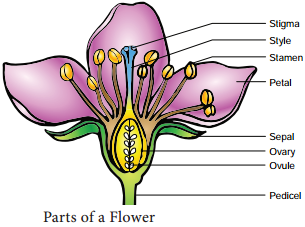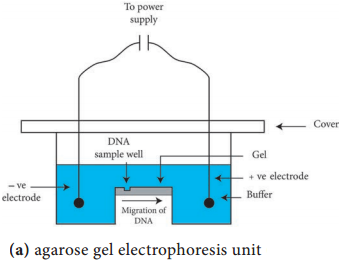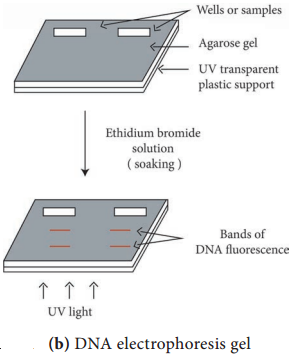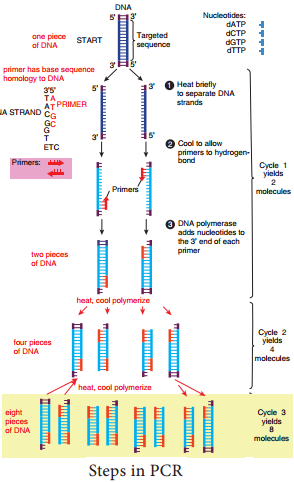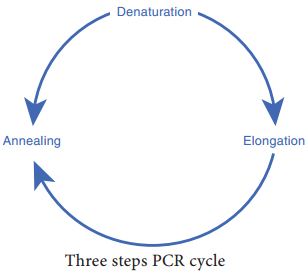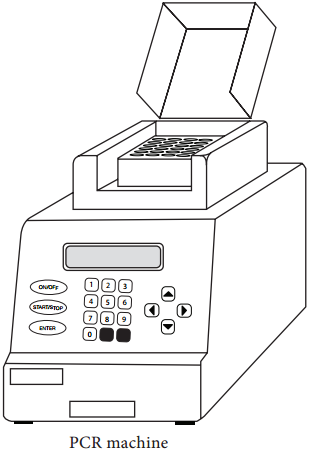Learninsta presents the core concepts of Biology with high-quality research papers and topical review articles.
Vegetative Propagation – Definition, Types, Examples & Explanations
Natural methods
Natural vegetative reproduction is a form of asexual reproduction in which a bud grows and develops into a new plant. The buds may be formed in organs such as root, stem and leaf. At some stage, the new plant gets detached from the parent plant and starts to develop into a new plant.
Some of the organs involved in the vegetative reproduction also serve as the organs of storage and perennation. The unit of reproductive structure used in propagation is called reproductive propagules or diaspores. Some of the organs that help in vegetative reproduction are given in Figure 1.1.
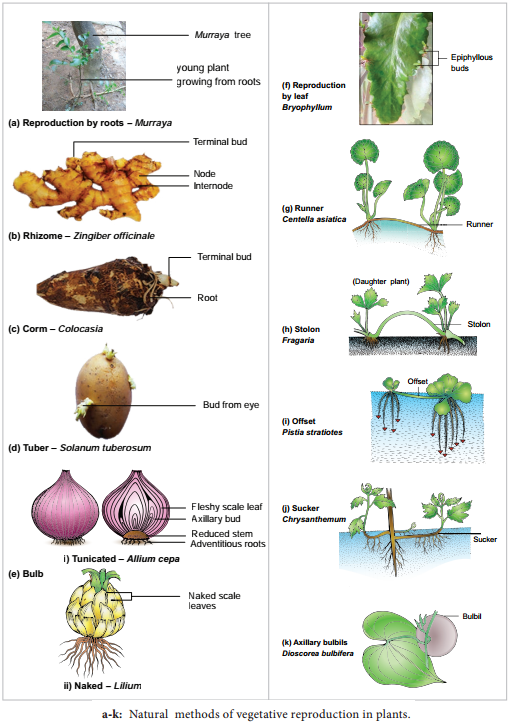
A. Vegetative reproduction in root
The roots of some plants develop vegetative or adventitious buds on them. Example Murraya, Dalbergia and Millingtonia. Some tuberous adventitious roots apart from developing buds also store food. Example Ipomoea batatus and Dahlia. Roots possessing buds become detached from the parent plant and grow into independent plant under suitable condition.
B. Vegetative reproduction in stem
From the Unit 3 of class XI (Vegetative morphology) you are familiar with the structure of various underground stem and sub aerial stem modifiations. Thse include rhizome (Musa paradisiaca, Zingiber offinale and Curcuma longa); corm (Amorphophallus and Colocasia); tuber (Solanum tuberosum); bulb (Allium cepa and Lilium) runner (Centella asiatica); stolon (Mentha, and Fragaria); offet (Pistia, and
Eichhornia); sucker (Chrysanthemum) and bulbils (Dioscorea and Agave). The axillary buds from the nodes of rhizome and eyes of tuber give rise to new plants.
C. Vegetative reproduction in leaf
In some plants adventitious buds are developed on their leaves. When they are detached from the parent plant they grow into new individual plants. Examples: Bryophyllum, Scilla, and Begonia. In Bryophyllum, the leaf is succulent and notched on its margin.
Adventious buds develop at these notches and are called epiphyllous buds. Thy develop into new plants forming a root system and become independent plants when the leaf gets decayed. Scilla is a bulbous plant and grows in sandy soils. The foliage leaves are long and narrow and epiphyllous buds develop at their tips. Thse buds develop into new plants when they touch the soil.
Advantages of natural vegetative reproduction
- Only one parent is required for propagation.
- The new individual plants produced are genetically identical.
- In some plants, this enables to spread rapidly. Example: Spinifex
- Horticulturists and farmers utilize these organs of natural vegetative reproduction for cultivation and to harvest plants in large scale.
Disadvantage of natural vegetative reproduction
New plants produced have no genetic variation.
Artificial Methods
Apart from the above mentioned natural methods of vegetative reproduction, a number of methods are used in agriculture and horticulture to propagate plants from their parts. Such methods are said to be artifiial propagation.
Some of the artifiial propagation methods have been used by man for a long time and are called conventional methods. Now-a-days, technology is being used for propagation to produce large number of plants in a short period of time. Such methods are said to be modern methods.
A. Conventional methods
The common methods of conventional propagation are cutting, grafting and layering.
a. Cutting:
It is the method of producing a new plant by cutting the plant parts such as root, stem and leaf from the parent plant. The cut part is placed in a suitable medium for growth. It produces root and grows into a new plant.
Depending upon the part used it is called as root cutting (Malus), stem cutting (Hibiscus, Bougainvillea and Moringa) and leaf cutting (Begonia, Bryophyllum). Stem cutting is widely used for propagation.
b. Graftng:
In this, parts of two different plants are joined so that they continue to grow as one plant. Of the two plants, the plant which is in contact with the soil is called stock and the plant used for graftng is called scion (Figure 1.2 a). Examples are Citrus, Mango and Apple.
There are different types of graftng based on the method of uniting the scion and stock. Thy are bud graftng, approach graftng, tongue graftng, crown graftng and wedge graftng.
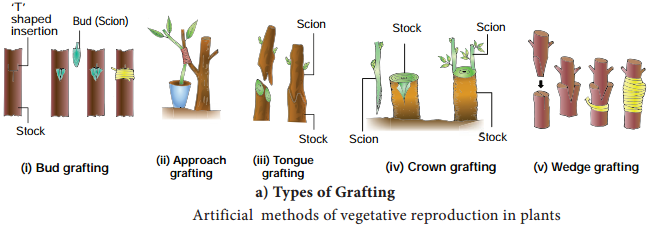
(i) Bud graftng:
A T – shaped incision is made in the stock and the bark is lifted. The scion bud with little wood is placed in the incision beneath the bark and properly bandaged with a tape.
(ii) Approach graftng:
In this method both the scion and stock remain rooted. The stock is grown in a pot and it is brought close to the scion. Both of them should have the same thickness. A small slice is cut from both and the cut surfaces are brought near and tied together and held by a tape. After 1-4 weeks the tip of the stock and base of the scion are cut of and detached and grown in a separate pot.
(iii) Tongue grafting:
A scion and stock having the same thickness is cut obliquely and the scion is fi into the stock and bound with a tape.
(iv) Crown grafting:
When the stock is large in size scions are cut into wedge shape and are inserted on the slits or clefts of the stock and fixed in position using graft wax.
(v) Wedge grafting:
In this method a slit is made in the stock or the bark is cut. A twig of scion is inserted and tightly bound so that the cambium of the two is joined.
c. Layering:
In this method, the stem of a parent plant is allowed to develop roots while still intact. When the root develops, the rooted part is cut and planted to grow as a new plant. Examples: Ixora and Jasminum. Mound layering and Air layering are few types of layering (Figure 1.2 b).
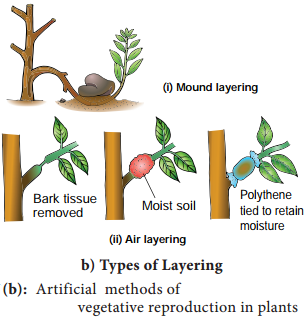
i. Mound layering:
The method is applied for the plants having flxible branches. The lower branch with leaves is bent to the ground and part of the stem is buried in the soil and tip of the branch is exposed above the soil. After the roots emerge from the part of the stem buried in the soil, a cut is made in parent plant so that
the buried part grow into a new plant.
ii. Air layering:
In this method the stem is girdled at nodal region and hormones are applied to this region which promotes rooting. The portion is covered with damp or moist soil using a polythene sheet. Roots emerge in these branches after 2-4 months. Such branches are removed from the parent plant and grown in a
separate pot or ground.
Advantages of conventional methods
- The plants produced are genetically uniform.
- Many plants can be produced quickly by this method.
- Some plants produce little or no seeds; in others, the seeds produced do not germinate. In such cases, plants can be produced in a short period by this method.
- Some plants can be propagated more economically by vegetative propagation. Example: Solanum tuberosum.
- Two diffrent plants with desirable characters such as disease resistance and high yield can be grafted and grown as a new plant with the same desirable characters.
Disadvantages of conventional methods
- Use of virus infected plants as parents produces viral infected new plants.
- Vegetative structures used for propagation are bulky and so they are diffilt to handle and store.
